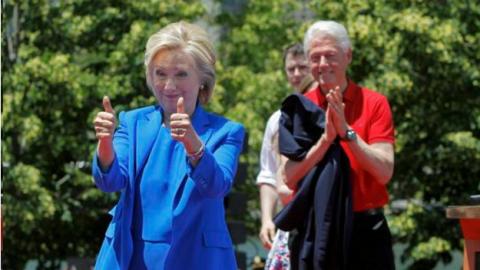Who Is the Real Hillary Clinton?

Originally published in The Hill.
Think back to the legendary game show of yesteryear, To Tell the Truth. And ask today: Will the real Hillary Clinton please stand up?
There’s the Hillary Clinton who is and always has been an activist, advocate, and idealist determined to advance civil rights, promote women’s equality, champion the strivers, and upend the status quo by using the levers of power to effect political and social change.
But no, there’s another Hillary Clinton, a calculating, privileged member of the elite who is too cozy with power, condescends to ordinary Americans, sees herself as above the law, and manipulates every word and sentence for political, personal, and financial gain.
Hillary Clinton certainly views herself as the former – as do her loyalists and supporters. But many Americans, even many Democrats, see only the latter.
With so much attention focused on Donald Trump’s chaotic and flailing reality show campaign, it’s tempting to overlook the steep hill Clinton must climb to connect with voters and gain the trust of the nation.
For years she has ascribed the deep hostility directed her way to a “vast right-wing conspiracy” or to ingrained resistance to a high-powered woman. But it’s not her political opponents or even Donald Trump who should worry her this election. It’s the unenthusiastic and tepid reception she gets from many who ought to support her but can’t yet bring themselves to do so.
For her to gain a mandate in November – to take the oath of office as the choice of a nation, not the lesser of two evils – it may depend on how well she understands those who resist her and convinces them that the real Hillary is exactly who she says she is.
To be sure, she may never win over the legions of Clinton haters and die-hard Republicans who reflexively disdain her. Whatever misgivings Republican loyalists may have about their likely standard-bearer, they are largely united in their refrain that they can “never vote for Hillary.”
Her real challenge is communicating with those millions of voters – independents, moderates, many Democrats and progressives – for whom the name Hillary evokes distrust at worst and ambivalence or resignation at best.
In an ideal Clinton world, these voters would examine the evidence, read her biography, admire her good deeds, and embrace the activist and compassionate Hillary as the rational choice to heal our divisions and address our challenges.
But to many of these Americans, Clinton is far from the solution they seek – and actually personifies the problem they detest.
To them, Washington has become a cartel where the powerful look out for each other, special interests drive legislation, the privileged gain access by writing big campaign checks, and ordinary citizens are humored for their votes but disregarded for their needs.
And this is not an isolated sentiment shared only by the disgruntled. In a 2015 Pew survey, seven in 10 Americans said that government policies after the recession benefited banks, corporations, and the wealthy but did nothing or very little for the middle class, small businesses, and the poor.
It is precisely this image of the Washington and corporate power elite – and the need to break it up – that has helped fuel the Trump and Sanders campaigns.
So when a candidate hobnobs regularly with wealthy donors, charms Wall Street financiers at $225,000 per speech, claims that she and her husband were “dead broke” after leaving the White House in 2001, and insists on playing by her own rules at the State Department, many voters see an imperial Hillary, not one of us.
And therefore those who might arguably gain the most from her advocacy – who would benefit from paid family leave, student debt relief, infrastructure spending, fair labor standards – instead denounce her as another elitist Washington politician who talks a good game but prefers the company of insiders and influencers.

The candidate and her supporters earnestly proffer her biography to counter this elitist image. They describe her work against school segregation, her lifelong advocacy for children, her longstanding commitment to social justice, and her defiance of norms and expectations limiting opportunities for women.
“I come from the Sixties,” Clinton said in one debate, proudly citing her generation’s civil rights, anti-war, and feminist activism to validate her anti-establishment credibility today.
But proclaiming her authentic bona fides doesn’t confer actual authenticity. And for the Clinton campaign that is the real imperative: understanding why many Americans don’t regard her the way she regards herself.
Nor does she help herself by studiously avoiding unscripted conversations with the press – thus choking off the spontaneity and authenticity Americans expect in our media age – and by lowering expectations for change by saying the only way to reach our goals is offering pinched ideas and incremental initiatives. Policy wonks, problem solvers, triangulators, and buttoned-down lawyers do not inspire people to vote.
Perhaps she needs to rediscover the passion and aspirational spirit of a student commencement speaker who in 1969 admonished our nation’s leaders for too often settling for the acceptable and not the better, for merely viewing “politics as the art of the possible.”
Instead, that student said, “the challenge now is to practice politics as the art of making what appears to be impossible possible.”The speaker? Hillary Rodham, now Clinton.
Originally published in The Hill.
Author Bio:
A former speechwriter and strategist for causes, candidates, and members of Congress, Leonard Steinhorn has written two books on American politics and culture and frequently writes for major print and online publications. He is currently a professor of communication at American University and a CBS News political analyst.






























































































































































































































































































































